Percent Error
Percent Error: Easy to understand
Imagine you’re baking a cake and following a recipe that says you need 200 grams of flour, but you accidentally add 220 grams. This is similar to the concept of percent error, where you measure how far off you are from the expected or “accepted” value—in this case, the extra flour compared to the recipe. Just as you can calculate your baking mistake by finding how much extra you added (20 grams) and expressing it as a percentage of the intended amount (200 grams), percent error measures the difference between an observed value and an accepted value, showing how "off-target" a measurement is in a standardized way.

Practice Version

Percent Error: The error of a reading expressed as a percentage of the accepted value. Percent error. Percent error in science is a way to compare how accurate a measurement is by showing how far off it is from the true or accepted value.